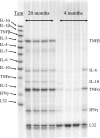Diets enriched in foods with high antioxidant activity reverse age-induced decreases in cerebellar beta-adrenergic function and increases in proinflammatory cytokines
- PMID: 12122072
- PMCID: PMC6757915
- DOI: 10.1523/JNEUROSCI.22-14-06114.2002
Diets enriched in foods with high antioxidant activity reverse age-induced decreases in cerebellar beta-adrenergic function and increases in proinflammatory cytokines
Abstract
Antioxidants and diets supplemented with foods high in oxygen radical absorbance capacity (ORAC) reverse age-related decreases in cerebellar beta-adrenergic receptor function. We examined whether this effect was related to the antioxidant capacity of the food supplement and whether an antioxidant-rich diet reduced the levels of proinflammatory cytokines in the cerebellum. Aged male Fischer 344 rats were given apple (5 mg dry weight), spirulina (5 mg), or cucumber (5 mg) either in 0.5 ml water by oral gavage or supplied in the rat chow daily for 14 d. Electrophysiologic techniques revealed a significant decrease in beta-adrenergic receptor function in aged control rats. Spirulina reversed this effect. Apple (a food with intermediate ORAC) had an intermediate effect on cerebellar beta-adrenergic receptor physiology, and cucumber (low ORAC) had no effect, indicating that the reversal of beta-adrenergic receptor function decreases might be related to the ORAC dose. The mRNA of the proinflammatory cytokines tumor necrosis factor-alpha (TNFalpha) and TNFbeta was also examined. RNase protection assays revealed increased levels of these cytokines in the aged cerebellum. Spirulina and apple significantly downregulated this age-related increase in proinflammatory cytokines, whereas cucumber had no effect, suggesting that one mechanism by which these diets work is by modulation of an age-related increase in inflammatory responses. Malondialdehyde (MDA) was measured as a marker of oxidative damage. Apple and spirulina but not cucumber decreased MDA levels in the aged rats. In summary, the improved beta-adrenergic receptor function in aged rats induced by diets rich in antioxidants is related to the ORAC dose, and these diets reduce proinflammatory cytokine levels.
Figures






References
-
- Bickford P. Motor learning deficits in aged rats are correlated with loss of cerebellar noradrenergic function. Brain Res. 1993;620:133–138. - PubMed
-
- Bickford P, Heron C, Young DA, Gerhardt GA, de la Garza R. Impaired acquisition of novel locomotor tasks in aged and norepinephrine-depleted F344 rats. Neurobiol Aging. 1992;13:475–481. - PubMed
-
- Bickford PC, Gould T, Briederick L, Chadman K, Pollock A, Young D, Shukitt-Hale B, Joseph J. Antioxidant-rich diets improve cerebellar physiology and motor learning in aged rats. Brain Res. 2000;866:211–217. - PubMed
-
- Cao G, Alessio HM, Cutler RG. Oxygen-radical absorbance capacity assay for antioxidants. Free Radic Biol Med. 1993;14:303–311. - PubMed
Publication types
MeSH terms
Substances
Grants and funding
LinkOut - more resources
Full Text Sources
Other Literature Sources
Medical
